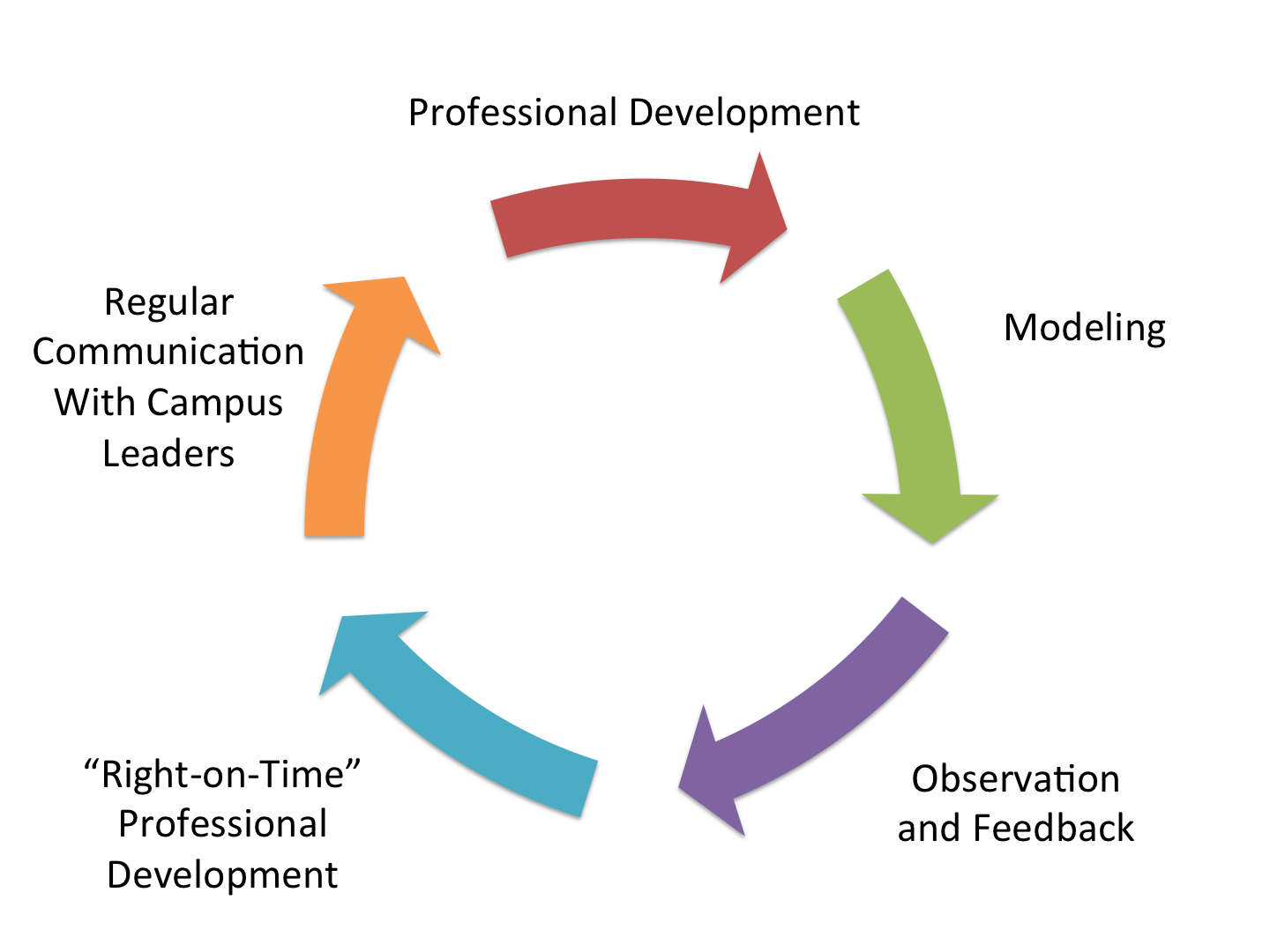Action Step L5 prompts you to adopt a specific coaching model. All effective coaching models should have certain elements in common, as seen in this graphic:

The graphic above illustrates the cyclical nature of coaching. Let’s explore each of the elements in the coaching cycle.
Professional development – Coaches work with teachers to help them implement the evidence-based practices that are the focus of professional learning experiences. These experiences may take the form of traditional large-group face-to-face training or professional development sessions. They may also occur in smaller groups and more informal professional development sessions. Coaches can also assist campus-based leadership teams in identifying needs for professional development based on data analysis.
Modeling – Coaches model evidence-based practices in the classroom so that teachers can experience the translation of theory learned during professional development sessions into practices that apply to the real world of the classroom. Modeling can provide the opportunity for teachers to make direct connections to their own instruction as they witness the successful use of new practices in their subject area and with their students.
Observation and feedback – Coaches observe teachers as they begin to implement evidence-based practices for themselves. Observations may be conducted after a modeling session. Observations can also occur prior to the planning or delivery of new professional development to gain insight into current practices. Whatever the purpose of the observation, teachers need to be informed of the observations and given feedback. Positive feedback on effective practices that are already in place is essential for creating a comfortable climate in which teachers are open to more change-oriented feedback in the future.
“Right-on-time” professional development – After observing teachers attempting to implement specific literacy practices, literacy coaches can convene a short, targeted session to address difficulties and misconceptions they observed during instruction. These sessions are less formal than other types of professional development but are very effective when provided immediately after the observations—within the same week—and when they provide concrete examples, modeling, and opportunities for teachers to practice and get real-time feedback on the specific practice.
Regular communication with campus leaders – To be effective, coaches require the support of campus leaders: administrators, department heads, team leaders, and others. Coaches should communicate regularly with campus leaders to share the focus of their efforts and how leaders can support these efforts. For example, coaches may remind campus administrators to notice when content teachers use best practices such as think-alouds to model the use of comprehension strategies during class. When administrators or department heads recognize teachers for their attempts to use new practices, their motivation to continue these practices increases.
Coaches do not evaluate teachers as administrators do in formal performance evaluations or appraisals. Nor should they provide evaluative information about the individual teachers they work with. While it may be tempting for administrators to ask for this information to inform their own role as campus leader, coaches must maintain the trust and confidentiality of the teachers with whom they work. The purpose of the coach’s classroom visits and other collaboration with teachers is to help improve instruction.
Coaches should let teachers and administrators know that they will provide campus leaders with only general feedback on group needs and progress for the purpose of planning future support and prioritizing resources. Coaches do not report information about individual teacher performance to supervisors.
Coaching teachers is an ongoing process with repeated visits and coaching conversations. Evaluative observations need to remain distinct from this process and occur only after sufficient time has been allowed for the coaching impact to occur. Personnel with both supervisory and coaching roles will need to establish a special relationship of trust with the teachers they are coaching. Schools with a sufficient number of such personnel can assign coaches to teachers whom they do not supervise. In any case, every effort should be made to separate the coaching and supervisory roles on your campus.

TO LEARN MORE: To learn more about implementing a coaching model, including how to evaluate its effectiveness, see The Center for Comprehensive School Reform and Improvement’s publication “Issue Brief: Instructional Coaching.”

NEXT STEPS: Depending on your progress in implementing a coaching model to support the goals of your data-informed plan for improving literacy instruction, you may want to consider some of the following next steps:
- Establish a coaching model, including roles, duties, and a schedule.
- Recruit and/or hire coaches with the suggested qualifications.
- Identify existing personnel who can perform coaching actions as part of a current role, such as a department head or instructional leader.
- Establish professional learning goals for coaches and plan for ongoing professional development about coaching.
- Introduce coaches and explain their roles to content-area teachers.
- Invite coaches to participate in the campus-based leadership team meetings when appropriate.
- Coordinate professional development activities with literacy coach support.
- Implement a process for identifying teachers who need more or fewer hours of coaching support.
- Assess the effectiveness of the coaching program.

